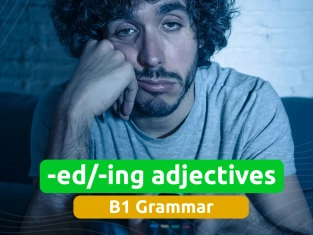by PushtoLearn
Adjectives
Table of Contents
Adjectives – Exercises
These exercises focus on Adjectives
Adjective + Noun
In English, adjectives typically come before the noun they describe.
|
Correct |
Incorrect |
|
It’s an expensive guitar. |
It’s a guitar expensive. |
|
She has a new car. |
She has a car new. |
Key Rule: Adjectives do not change based on the noun. Whether the noun is singular or plural, the adjective remains the same.
|
Singular |
Plural |
|
This is a blue shirt. |
These are blue shirts. |

Am/Is/Are + Adjective
Adjectives can also stand alone after the verb be (am, is, are).
|
Example |
|
This guitar is expensive. |
|
Her car is new. |
In questions, the adjective comes after be + subject:
-
Is your car new?
-
Are your classmates nice?
Feel/Look/Smell/Sound/Taste + Adjective
Adjectives are also used after sense verbs like feel, look, smell, sound, and taste. These verbs link the subject to the adjective that describes it.
|
Sense Verb |
Example |
|
Feel |
I feel tired. |
|
Look |
You look amazing today. |
|
Smell |
This flower smells wonderful. |
|
Sound |
That idea sounds interesting. |
|
Taste |
This cake tastes delicious. |
Adjectives Have No Plural Form
Unlike nouns, adjectives in English do not have plural forms.
|
Correct |
Incorrect |
|
She has blue eyes. |
She has blues eyes. |
|
These are my favorite shoes. |
These are my favorites shoes. |
Using Very and Quite with Adjectives
We can use very or quite to intensify the meaning of an adjective:
|
Modifier |
Example |
|
Very |
It’s very expensive. |
|
Quite |
It’s quite nice. |
Note: "Very" indicates a stronger intensity than "quite." For example:
-
The book is very interesting (a strong interest).
-
The book is quite interesting (a mild interest).
Common Errors with Adjectives
-
Using the wrong position:
-
Incorrect: She has a house beautiful.
-
Correct: She has a beautiful house.
-
Pluralizing adjectives:
-
Incorrect: He has browns eyes.
-
Correct: He has brown eyes.
-
Overusing intensifiers:
-
Incorrect: This movie is very, very amazing.
-
Correct: This movie is very amazing.
-
Skipping sense verbs:
-
Incorrect: You tired.
-
Correct: You look tired.
Everyday Use of Adjectives
Here’s how adjectives are used in daily conversations:
|
Context |
Example |
|
Appearance |
She has long black hair. |
|
Personality |
He’s a kind and helpful teacher. |
|
Feelings |
I’m happy with the results. |
|
Food |
The soup is hot and spicy. |
|
Places |
It’s a small but cozy apartment. |
FAQ: Adjectives
What is an adjective?
An adjective is a word that describes a noun or pronoun. For example, in "a red apple," the word "red" is an adjective.
Where do adjectives go in a sentence?
Adjectives usually come before the noun they describe or after verbs like "be" (is, are) or sense verbs (feel, look).
Can adjectives have plural forms?
No, adjectives do not change based on the number of nouns. For example:
-
Singular: A blue car.
-
Plural: Blue cars.
How do I use very and quite with adjectives?
You can place them before the adjective to intensify it. For example:
-
It’s very cold outside.
-
This movie is quite boring.
Can I use more than one adjective for the same noun?
Yes, you can, but follow the correct order:
-
A beautiful red dress (opinion + color).

